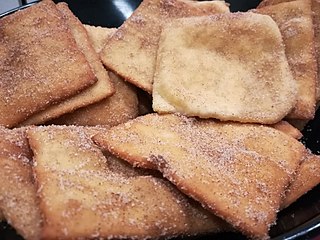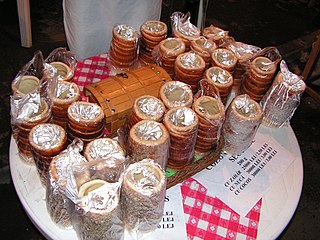
Dessert is a course that concludes a meal. The course consists of sweet foods, such as confections, and possibly a beverage such as dessert wine and liqueur. In some parts of the world, such as much of central and western Africa, and most parts of China, there is no tradition of a dessert course to conclude a meal.

A doughnut or donut is a type of leavened fried dough. It is popular in many countries and is prepared in various forms as a sweet snack that can be homemade or purchased in bakeries, supermarkets, food stalls, and franchised specialty vendors. Doughnut is the traditional spelling, while donut is the simplified version; the terms are often used interchangeably.

Puerto Rican cuisine has its roots in the cooking traditions and practices of Europe, Africa and the native Taínos. Since the latter part of the 19th century, Puerto Rican cuisine can be found in several other countries.

A churro is a type of fried dough from Spanish and Portuguese cuisine. They are also found in Latin American cuisine and the cuisine of the Philippines and in other areas that have received immigration from Spanish and Portuguese-speaking countries, especially in the Southwestern United States and France.

Dulce de leche, also known as caramelized milk or milk jam in English, is a confection from Latin America prepared by slowly heating sugar and milk over a period of several hours. The resulting substance, which takes on a spreadable, sauce-like consistency, derives its rich flavour and colour from non-enzymatic browning. It is typically used to top or fill other sweet foods.

Rice pudding is a dish made from rice mixed with water or milk and other ingredients such as cinnamon, vanilla and raisins.

Gulab jamun is a milk-solid-based sweet, originating in India and a type of mithai popular in India, Nepal, Pakistan, the Maldives, and Bangladesh, as well as Myanmar. It is also declared as the national dessert of Pakistan officially by Government of Pakistan. It is also common in nations with substantial populations of people with South Asian heritage, such as Mauritius, Fiji, the Malay Peninsula, Great Britain, South Africa, and the Caribbean countries of Jamaica, Trinidad and Tobago, Guyana, and Suriname. It is made mainly from milk solids, traditionally from khoya, which is milk reduced to the consistency of a soft dough. Modern recipes call for dried or powdered milk instead of khoya. It is often garnished with dried nuts such as almonds and cashews to enhance flavour. Started by Gits Food in 2020, World Gulab Jamun Day is celebrated on 10th October every year.

A sopaipilla, sopapilla, sopaipa, or cachanga is a kind of fried pastry and a type of quick bread served in several regions with Spanish heritage in the Americas. The word sopaipilla is the diminutive of sopaipa, a word that entered Spanish from the Mozarabic language of Al-Andalus. The original Mozarabic word Xopaipa was used to mean bread soaked in oil. The word is derived in turn from the Germanic word suppa, which meant bread soaked in liquid.

Sri Lankan cuisine is known for its particular combinations of herbs, spices, fish, vegetables, rices, and fruits. The cuisine is highly centered around many varieties of rice, as well as coconut which is an ubiquitous plant throughout the country. Seafood also plays a significant role in the cuisine, be it fresh fish or preserved fish. As a country that was a hub in the historic oceanic silk road, contact with foreign traders brought new food items and cultural influences in addition to the local traditions of the country's ethnic groups, all of which have helped shape Sri Lankan cuisine. Influences from Indian, Indonesian and Dutch cuisines are most evident with Sri Lankan cuisine sharing close ties to other neighbouring South and Southeast Asian cuisines.

A buñuelo is a fried dough fritter found in Spain, Latin America, Israel, and other regions with a historical connection to Spaniards or Sephardic Jews, including Southwest Europe, the Balkans, Anatolia, and other parts of Asia and North Africa. Buñuelos are traditionally prepared at Christmas, Ramadan, and among Sephardic Jews at Hanukkah. It will usually have a filling or a topping. In Mexican cuisine, it is often served with a syrup made with piloncillo.

Colombian cuisine is a compound of the culinary traditions of the six main regions within the country. Colombian cuisine varies regionally and is particularly influenced by Indigenous Colombian, Spanish, and African cuisines, with slight Arab influence in some regions. Furthermore, being one of the most biodiverse countries in the world, Colombia has one of the widest variety of available ingredients depending on the region.
Dominican cuisine is made up of Spanish, indigenous Taíno, Middle-Eastern and African influences. Many Middle-Eastern dishes have been adopted into Dominican cuisine, such as the "Quipe" that comes from the Lebanese kibbeh.

Uruguayan cuisine is a fusion of cuisines from several European countries, especially from Mediterranean foods from Spain, Italy, Portugal and France. Other influences on the cuisine resulted from immigration from countries such as Germany and Scotland. Uruguayan gastronomy is a result of immigration, rather than local Amerindian cuisine, because the new colonies did not trust the native Charrúa people. Spanish influences are very abundant: desserts like churros, flan, ensaimadas yoo (Catalan sweet bread), and alfajores were all brought from Spain. There are also all kinds of stews known as guisos or estofados, arroces, and fabada. All of the guisos and traditional pucheros (stews) are also of Spanish origin. Uruguayan preparations of fish, such as dried salt cod (bacalao), calamari, and octopus, originate from the Basque and Galician regions, and also Portugal. Due to its strong Italian tradition, all of the famous Italian pasta dishes are present in Uruguay including ravioli, lasagne, tortellini, fettuccine, and the traditional gnocchi. Although the pasta can be served with many sauces, there is one special sauce that was created by Uruguayans. Caruso sauce is a pasta sauce made from double cream, meat, onions, ham and mushrooms. It is very popular with sorrentinos and agnolotti. Additionally, there is Germanic influence in Uruguayan cuisine as well, particularly in sweet dishes. The pastries known as bizcochos are Germanic in origin: croissants, known as medialunas, are the most popular of these, and can be found in two varieties: butter- and lard-based. Also German in origin are the Berlinese known as bolas de fraile, and the rolls called piononos. The facturas were re-christened with local names given the difficult German phonology, and usually Uruguayanized by the addition of a dulce de leche filling. Even dishes like chucrut (sauerkraut) have also made it into mainstream Uruguayan dishes.
Panamanian cuisine is a mix of African, Spanish, and Native American techniques, dishes, and ingredients, reflecting its diverse population. Since Panama is a land bridge between two continents, it has a large variety of tropical fruits, vegetables and herbs that are used in native cooking.

Natillas is a term in Spanish for a variety of custards and similar delicacies in the Spanish-speaking world. In Spain, this term refers to a custard dish made with milk and eggs, similar to other European creams as crème anglaise. In Colombia, the delicacy does not include eggs, and is called natilla.

Kürtőskalács is a spit cake specific to the Székelys of Transylvania. Originally popular in the Hungarian-speaking regions of Romania, more predominantly the Székely Land, it became popular in both, Romania and Hungary. The first written record dates back to 1679 and was found in the village of Úzdiszentpéter, while the first recipe appears in a manuscript cookbook dated in 1781. Earlier a festive treat, now it is part of everyday consumption. In Transylvania, a similar pastry to Kürtőskalács is Baumstriezel, originating from the Saxon communities.

Suspiro de limeña or Suspiro a la limeña is a dessert of Peruvian gastronomy. A literal translation of the dessert's name is "Sigh of the lady from Lima".
A great variety of cassava-based dishes are consumed in the regions where cassava is cultivated, and they include many national or ethnic specialities.

Dumpling is a broad class of dishes that consist of pieces of dough wrapped around a filling, or of dough with no filling. The dough can be based on bread, flour or potatoes, and may be filled with meat, fish, cheese, vegetables, fruits or sweets. Dumplings may be prepared using a variety of methods, including baking, boiling, frying, simmering or steaming and are found in many world cuisines.
















